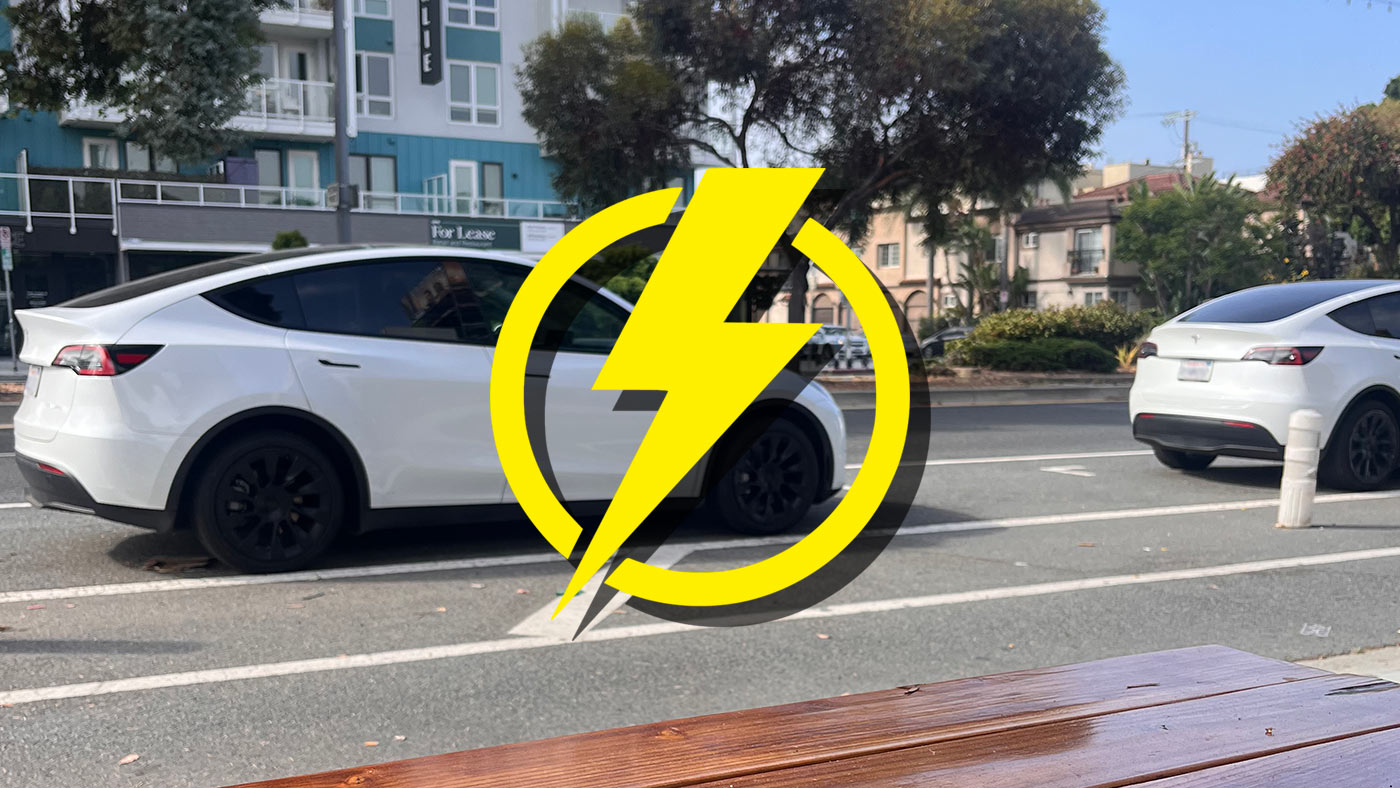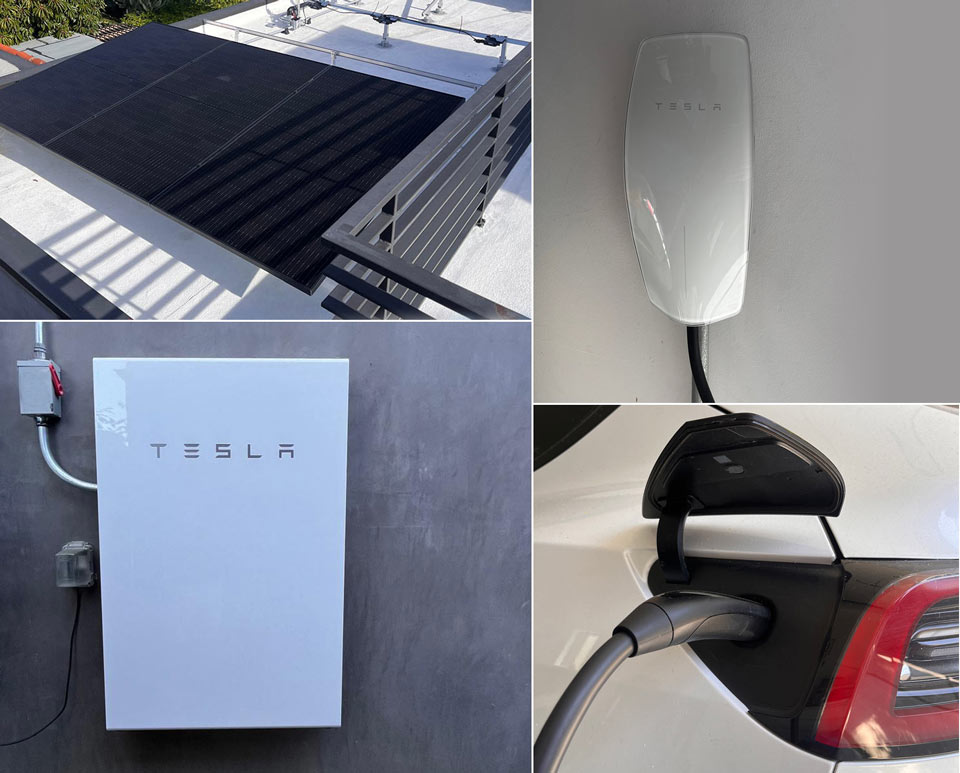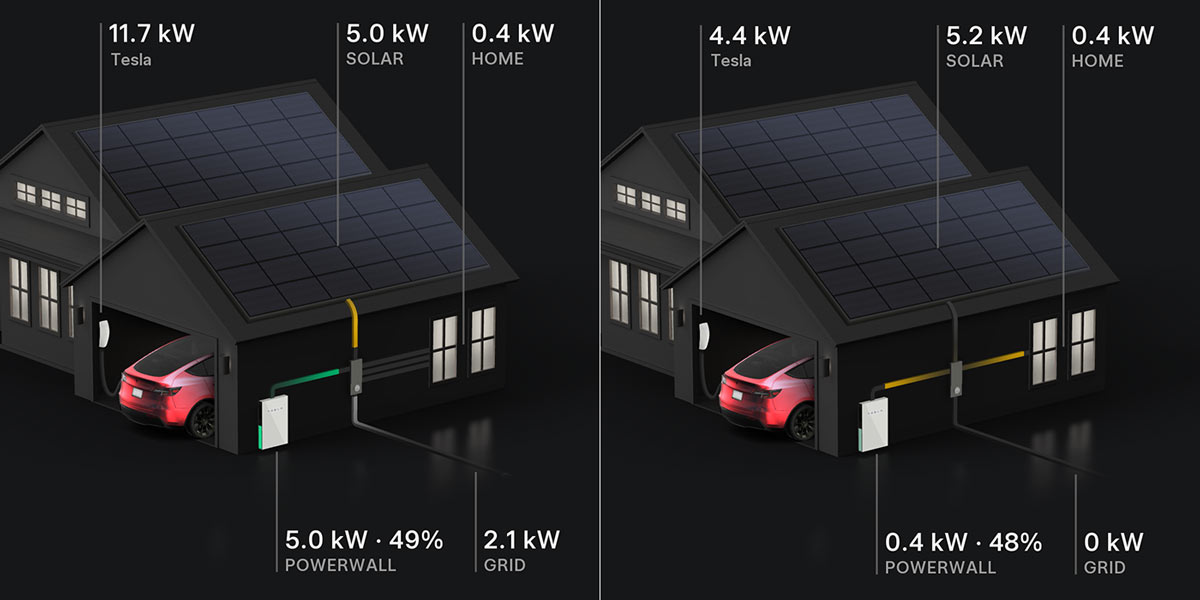Towards an Electrified Future

To lower our carbon footprint and our energy costs, we recently installed rooftop solar with a Tesla Powerwall and an EV charger at home. Here's what I learned after the first couple of months of using it.
Before I got involved with this project, I had no idea how much electricity different devices consume and how this is even calculated. So my first objective was to update my knowledge.

Basics of electricity
When dealing with electricity at the home, the most common unit is the kiloWatt-hour (kWh). A kiloWatt-hour is a unit of "work". It is defined as power (the "kiloWatt" part) applied over time (the "hour" part).
It is used to describe how much electricity was consumed. For example, our utility bill for January-March 2024 stated that we used 2416 kWh.
The amount of electricity generated by solar panels at any moment is given in kW (kiloWatts, without the hour). For example, at peak sunlight, our rooftop generates 7 kW. Throughout the day, it produces between 28 and 56 kWh, depending on the weather.
How much power do we need?
A typical home is full of devices that consume power at different rates throughout the day, so the answer to this question is not straightforward.
So for starters, I looked at some typical household items and how much power they consume:
- LED light bulb - 0.01 kW (a smart bulb also uses 0.0004 kWh on standby)
- Wifi router - 0.03 kW
- laptop - 0.09 kW
- 65" LED TV - 0.12 kW
- Playstation - 0.2 kW
- fridge - 0.6 kW
- microwave - 1 kW
- washing machine - 1 kW
- dishwasher - 1.8 kW
- electric bike battery, full charge - 0.96 kWh
- smartphone battery, full charge - 0.02 kWh
This list assumes modern and energy efficient equipment. Oldschool incandescent bulbs or a 20 year old fridge could easily consume 10 times as much!
In the list above, I use kW for how much power a device needs to operate, but kWh for the capacity of batteries.
Four hours of running the TV will use 0.12 kW x 4 h = 0.48 kWh. A dishwasher cycle lasts about 2 hours and in that time it will use around 2 kWh. A WiFi router operates non-stop so it consumes 0.03 kW x 24 h = 0.72 kWh of electricity each day.
On the other hand, if you plug your e-bike to a charger when it has 0% battery, it will use 0.96 kWh to charge up to 100% and then stop. The charging process might be longer than 1 hour though, so using kWh make more sense in this context.
The point is that you will not be able to calculate exactly how much power all the devices and appliances use, but it's good to have a sense of scale.
Electronics
The first thing I noticed is how little energy a smartphone battery needs! It is the most versatile device in our lives and yet it requires only a minimal amount of power to operate. The power generated by the solar panels could charge hundreds of smart phones every day. It's truly a miracle of modern technology.
All other household electronics also use relatively little energy. That amount is easily generated by the rooftop solar even on a cloudy day. In the evening, when we watch Netflix shows or play games, this is also easily covered by the energy stored in the Powerwall.
Charging the EV
When it comes to energy consumption, EV is the elephant in the room. We drive a Tesla Y that we typically charge up to 80% which allows for 200 miles of range. On an average day we drive 50 miles and so we use about a quarter of the battery. Since 80% of the battery amounts to 60 kWh, our daily needs are around 15 kWh.
Voltage and current
Before getting deeper into EV charging, there are two other aspects of electric power that I needed to revisit: voltage and current.
These values are typically best illustrated by a "water flowing through a pipe" analogy. Voltage is the pressure inside the pipe and the current represents the amount of water that passes through it. Voltage is measured in volts (V) and the current in amperes (A).
In the US, outlets supply power at 110V/12A, whereas in Europe 220V/6A is used. Many electric devices use transformers to change the voltage and current for their own needs. For example, a mobile phone charger works with 5V and a current between 0.5 and 2.5A. The EV charger on the other hand uses 240V and up to 48A.
There is a simple formula used to calculate the amount of power needed based on the voltage and the current:
voltage (V) x current (A) = power (W)
If you use the EV charger parameters mentioned above, we get:
240 V * 48 A = 11520 W (11,52 kW)
In other words, charging the car for a period of 1 hour will require 11.52 kWh of energy.
In case of the Tesla Y, 1 hour of charging adds 44 miles of range which is almost all we need on an average day. But there is a catch! 11.52 kW is more than the rooftop solar can produce even at noon on a sunny day. If I charge the car at full speed, it will end up using some grid power.

Fortunately, the current can be adjusted in the Tesla app. If I set the current to 24 A and plug it in around mid-day, the EV will charge from solar only.
Tesla offers an option called Charge On Solar which is supposed to automatically adjust the current to match the amount of solar energy available, but I was not able to make it work so far.
That being said, charging the car using some grid power is perfectly fine. I am just geeking out.
Making it through the night
The Tesla Powerwall can store 13 kWh of electric power. It takes 2-3 hours to fully charge it in the morning. After that, the battery is idle until the sun sets. This is when it starts discharging to bring power to our home. Those 13 kWh do not always get us through the night though. When that happens, the system switches to the grid automatically.
Installing an additional Powerwall could solve that problem. On the other hand, LAWPD, our utility provider, offers net metering. This means the power we export during the day is used as credits for what we import at night. The only drawback is that energy imported from the grid at night is not 100% clean.
Visualizing energy production & usage
To sum up: energy generated by solar panels is used to power our home first, then charge the Powerwall and the EV. Finally, any surplus is exported to the grid.
The Tesla app has some great data visualization tools that illustrate how this plays out on any given day:
-
![]() The amount of generated electricity reflects the trajectory of the sun. On a cloudy day, this graph is more choppy. The colors show what ther power was used for: home (blue), Powerwall charging (green), EV charging (red), export to the grid (grey).
The amount of generated electricity reflects the trajectory of the sun. On a cloudy day, this graph is more choppy. The colors show what ther power was used for: home (blue), Powerwall charging (green), EV charging (red), export to the grid (grey).
-
![]() Sources used to power our home. At night, we run on the Powerwall (green on the left). When it's discharged, the system switches to grid power (gray) for a few hours. When the sun comes up, the solar energy takes over (yellow) until the evening when a recharged Powerwall is ready to go again.
Sources used to power our home. At night, we run on the Powerwall (green on the left). When it's discharged, the system switches to grid power (gray) for a few hours. When the sun comes up, the solar energy takes over (yellow) until the evening when a recharged Powerwall is ready to go again.
-
![]() The power imported from the grid at night (blue) vs. the power exported during the day (yellow). The parts when nothing happens are when we use all the solar locally (morning hours) or we get all the power we need from the Powerwall (evenings).
The power imported from the grid at night (blue) vs. the power exported during the day (yellow). The parts when nothing happens are when we use all the solar locally (morning hours) or we get all the power we need from the Powerwall (evenings).
-
![]() May 2024 was the first month of our solar roof operation. Despite the cloudy weather ("May gray" as we call it in LA), we were able to export more energy than we imported!
May 2024 was the first month of our solar roof operation. Despite the cloudy weather ("May gray" as we call it in LA), we were able to export more energy than we imported!
What's next?
Generating our own electricity and driving an EV is a good first step. But the road to decarbonizing our home is not over yet.
Natural gas appliances
We need to replace all our gas powered appliances with electric ones when they approach their end-of-life. This means getting rid of the AC unit and putting a heat pump in its place. We also need to install an electric water heater, an induction stove and an electric dryer.
Most of the appliances we use at this moment are not old enough to be replaced yet. But we already took the decision that we won't get a new fossil fuel appliance for our home ever gain.
The other car
Our second car still runs on fossil fuels. It's an SUV, which is not great for the environment but we still need a large car with a good range. The good new is that, as the charging infrastructure grows, EVs become more practical and reliable for road trips.
The car is not yet ready to be replaced, but we drive much less often than before.
For fossil fuels, the writing is on the (power)wall.
In 2024, it is no longer a question of "if" but "when" all our appliances and cars will be electric. I am convinced that fossil fuels will become relics of a bygone era faster than most of us can imagine. Here are a few reasons why.
First of all, electricity is universal. It can power your car, your smartphone and everything in between. Having all our devices powered the same way greatly simplifies how our world is built and makes a lot of economic sense.
Second, generating electric power is getting cheaper every year. At the same time, the amount of energy that hits the earth on any given day is huge. If only we harness it, we will have more than enough.
Which brings me to the last, key factor. Given what we know about the effects of CO2 emissions on the climate, if we want our civilization to continue to flourish (or to continue at all), we need to switch to clean energy real fast!




